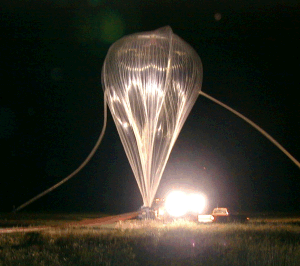
|
DCB Multiplexer Relays Data From Canadian Ozone Research Balloon |

|
The critical data collected in the balloon experiment was transmitted to the ground station via radio using DCB multiplexers. DCB created special firmware for this project, firmware that allows the data stream to operate one way only, from the balloon to the ground station. This allowed the use of standard off-the-shelf DCB multiplexers in this unique application.
DCB developed a protocol that allowed the ground station to capture the instrument data in real time for all the individual channels (approximately 12 instruments generating data, each using a separate DCB multiplexer channel) and for the composite of all the channels.
Scientific Instrumentation Limited, the company managing the project, wrote a special PC program that allowed for capture of the instrumentation data in real time to the PC, as a backup to allow later off line data analysis if any data was missed by the equipment reading the individual channels.
First, the payload was to drop when a guillotine system designed to cut the steel cables tethering it to the balloon failed to cut the cables. The mechanism fired, but for some reason, it did not cause the payload to drop and parachute to the ground. Second, a valve was opened to let the helium out of the top of the balloon, but it appears that the valve became plugged by some balloon plastic. So the balloon, rather than dropping to earth as planned, started off on its 11 day journey.
The Canadian Air force attempted to shoot down the balloon, but failed to bring it to earth. The failure is probably due to hitting the balloon below its midpoint, or equator, where the gas pressure is too low to get the balloon down quickly. Also, the balloon likely had holes shot into it that were only the size of a human finger, not a very large gas leak for 25 story high balloon.
All this illustrates the frustration of balloons. Fossett's balloon went down in the Pacific before the intended end of the trip, and the helium filled research balloon would not come down as intended.
The special firmware used in this application was delivered to the customer less than 60 days after receipt of the order. DCB often creates customized firmware for unique applications. Firmware options allow standard hardware platforms to perform unique tasks in data acquisition, remote control, security, broadcast, and scientific missions as well as standard data communications.
| Data Comm for
Business Inc. 2949 County Road 1000 E Dewey, Il 61840 |
Voice:
217-897-6600 Toll Free: 800-4-DCB-NET Toll Free: 800-432-2638 |
Email: Contact Page Web: www.dcbnet.com Fax: 217-897-8023 |
|
| All DCB web pages copyright ©1995- Data Comm for
Business, All rights reserved. EtherPath®, EtherSeries®, EtherPoll®, EtherBridge® and EtherModem® are Registered Trademarks of Data Comm for Business, Inc. |
|||